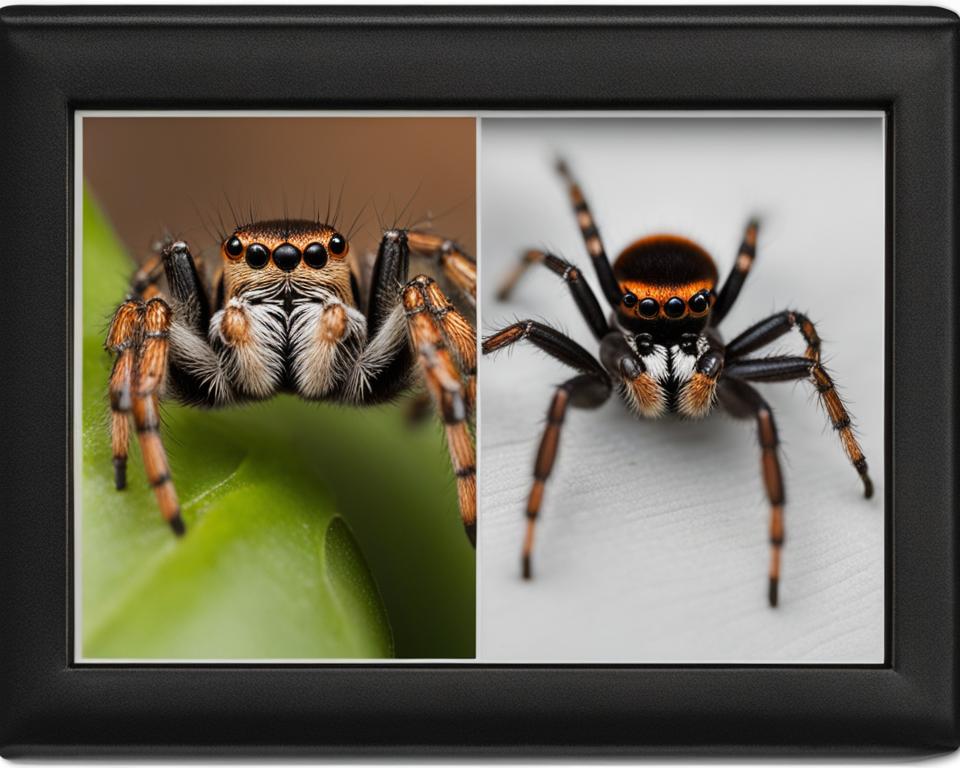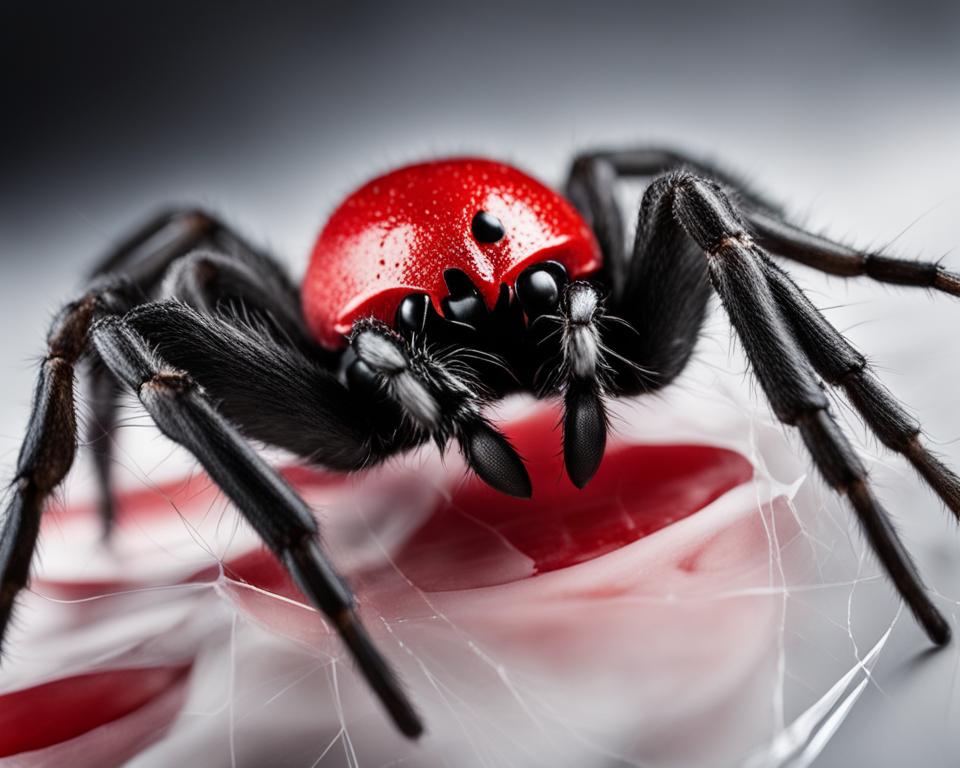When it comes to spiders, there are several different species that you may come across. Two of the most common types are the jumping spider and the brown recluse spider. While both spiders may look similar at first glance, there are several key differences that you should be aware of.
Identification is crucial when dealing with spiders, especially when it comes to venomous species like the brown recluse spider. Knowing the differences can help you take the appropriate precautions in case of an encounter or spider bite.
Key Takeaways:
- Jumping spiders and brown recluse spiders are two common spider species.
- Proper identification is important, especially with venomous spiders like the brown recluse.
- Understanding the key differences between the two can help you stay safe and take appropriate precautions.
- Stay alert and seek medical attention if you experience any spider bite symptoms.
- By following these tips, you can stay informed and avoid unnecessary harm.
Physical Characteristics
The key to differentiating between the jumping spider and the brown recluse spider lies in their physical characteristics. Jumping spiders are small in size, usually around 4mm to 2 centimeters in length, with a stout and fuzzy appearance. They have eight eyes, with two large front eyes that provide excellent vision for hunting. Their colors vary, with some having iridescent green, yellow, or orange markings.
On the other hand, brown recluse spiders are typically brown in color, with a violin-shaped marking on their head and a smooth, featureless body. They typically have a leg span of about two to three inches in diameter, and they are known for their long and uniform legs. It’s worth noting that immature brown recluse spiders have a lighter shade, and their marking may not yet be fully apparent.
In summary, while jumping spiders are small, brightly colored, and fuzzy, brown recluse spiders are larger, uniform in color, and lack distinctive markings, with a violin-shaped marking on their head.
Behavioral Differences
Understanding the habits of jumping spiders and brown recluse spiders can help you identify their presence and potential risks. Jumping spiders are active during the day and may be found in gardens or on walls. They are known for their exceptional jumping ability, which they use to catch prey. Brown recluse spiders, on the other hand, are active at night and may be found in dark, damp places like basements or closets.
Jumping spiders are generally harmless to humans and are not aggressive. They typically prefer to flee from danger rather than attack, unless provoked. Brown recluse spiders, in contrast, can be quite aggressive and will bite if they feel threatened. You may accidentally come into contact with them when putting on clothes or shoes that have been stored in a dark place.
Did You Know? Brown recluse spiders are known to engage in cannibalism, feeding on other brown recluse spiders.
Identifying the Species
Accurately identifying the jumping spider and brown recluse spider is crucial for effective management and prevention of encounters. By knowing their distinguishing features, you can quickly identify which species you are dealing with.
The jumping spider is generally smaller, measuring up to 0.75 inches long. It has a robust and agile body, typically with vibrant colors such as red, green, and blue. The distinguishing features of this spider include a stout build, prominent eyes, and an ability to jump.
On the other hand, the brown recluse spider is larger, measuring approximately 1 inch long. Its color can range from light brown to dark brown, with a violin-shaped marking on its cephalothorax. The doctors often identify this species based on its eyes, which are arranged in three pairs and located in two rows.
Take note that while the brown recluse spider’s violin marking is a crucial identification feature, not all brown spiders have it. Furthermore, other harmless spiders may have similar features such as color or eye arrangement. Therefore, it is essential to observe the spider’s overall appearance and behavior to confirm the spider’s species accurately.
Remember that identifying a spider’s species can be challenging and should only be attempted by experts or trained professionals.
Venomous Spider Comparison
When it comes to venomous spiders, both the jumping spider and the brown recluse spider pose potential risks to humans. The brown recluse spider produces a potent venom that can cause severe reactions, while the jumping spider generally has a milder venom that produces mild symptoms. However, reactions to spider bites can vary from person to person, so it’s important to be aware of the common symptoms associated with these bites.
Spider Bite Symptoms
The symptoms of a jumping spider bite include pain, redness, and mild swelling around the bite area. In contrast, the bite of a brown recluse spider can cause more severe symptoms, such as fever, chills, weakness, and necrosis (dead tissue). Necrosis can occur days after the bite, and if left untreated, can lead to serious complications.
Spider Bite Symptoms Comparison

| Jumping Spider | Brown Recluse Spider | |
|---|---|---|
| Symptoms | Pain, redness, mild swelling | Fever, chills, weakness, necrosis |
| Severity | Mild | Severe |
| Treatment | Symptomatic | Antivenom, wound care |
Spider Bite Treatment
If you suspect you have been bitten by a spider, it’s important to seek medical attention right away. For a mild jumping spider bite, symptomatic treatment may be all that’s needed to alleviate discomfort. In the case of a brown recluse spider bite, antivenom and wound care may be necessary to manage more severe symptoms and prevent further complications.
Overall, both the jumping spider and the brown recluse spider are venomous and potentially dangerous to humans. By understanding the symptoms and treatment options associated with spider bites, you can take appropriate precautions and seek medical help when needed.
How to Differentiate
Encounters with spiders can be frightening, especially if you are unsure of the species. Differentiating between the jumping spider and the brown recluse is crucial for reducing the risk of spider bites. Here are some tips to keep in mind:
- Look at the eyes: Jumping spiders have eight eyes arranged in three distinct rows, while brown recluses have six eyes arranged in pairs.
- Observe the movement: Jumping spiders are active and agile, known for their quick movements and ability to jump, while brown recluses move slowly and tend to hide in dark, quiet places.
- Examine the coloring: Jumping spiders come in various bright colors and patterns, while brown recluses are uniformly brown with a characteristic violin-shaped marking.
- Check the location: Jumping spiders are commonly found outdoors, while brown recluses prefer to live in dark, undisturbed indoor spaces.
To avoid spider bites, it is essential to take proper precautions:
- Wear protective clothing when working outdoors or in areas prone to spider infestations.
- Shake out clothing and shoes before putting them on.
- Seal cracks and gaps in windows and doors to prevent spiders from entering your home.
- Regularly clean and declutter your home to eliminate potential hiding spots for spiders.
- If you suspect a spider bite, seek medical attention immediately.
Understanding the Risks
Spider bites can be a common occurrence, and it is essential to understand the symptoms and treatments associated with them. Both the jumping spider and the brown recluse spider have venomous bites that can cause uncomfortable symptoms and, in rare cases, can be life-threatening. Common symptoms of spider bites include:
- itching or pain at the bite site
- redness and swelling
- mild to severe muscle pain and spasms
- fever, chills, and sweating
- headache and body aches
If you experience any of these symptoms after a spider bite, seeking medical attention is crucial. In some instances, severe reactions like anaphylaxis may occur, and immediate medical assistance is necessary.
Treatment for spider bites may include pain relief medication, antibiotics to prevent infection, and antihistamines to reduce swelling and itching. If the symptoms are severe, hospitalization may be necessary.

Conclusion
By now, you have learned about the key differences between the jumping spider and the brown recluse spider. Knowing their physical characteristics and behavioral habits can help you accurately identify the species and prevent potential risks.
Remember, if you experience spider bite symptoms, seek professional medical advice. Avoid unnecessary harm by staying informed and taking appropriate precautions when encountering these two spider species.
Stay safe and use this knowledge to protect yourself from potential danger associated with jumping spider vs brown recluse encounters.
FAQ
What are the key differences between a jumping spider and a brown recluse spider?
The key differences between a jumping spider and a brown recluse spider lie in their physical characteristics, behavior, and venomous nature. While jumping spiders are generally harmless and have excellent jumping abilities, brown recluse spiders are venomous and can cause serious health issues if bitten. It is essential to understand these distinctions for proper identification and dealing with encounters.
What are the physical characteristics of a jumping spider and a brown recluse spider?
Jumping spiders are usually small to medium-sized, have compact bodies with robust legs, and are known for their vibrant colors and iridescent markings. In contrast, brown recluse spiders are typically larger, have long legs, and are light to dark brown in color. Brown recluse spiders are also known for their distinctive violin-shaped marking on their cephalothorax.
How do the behaviors of jumping spiders and brown recluse spiders differ?
Jumping spiders are active daytime hunters that use their exceptional vision and agility to locate and capture prey. They do not spin webs to catch their food. On the other hand, brown recluse spiders are nocturnal and are usually found hiding in dark and secluded places. They build irregular webs where they wait for their prey to become ensnared.
How can I identify a jumping spider from a brown recluse spider?
To accurately identify a jumping spider from a brown recluse spider, you should consider their physical characteristics. Look for vibrant colors and iridescent markings, as well as their ability to jump in the case of a jumping spider. The brown recluse spider can be recognized by its overall brown color, long legs, and the violin-shaped marking on its cephalothorax.
Are jumping spiders and brown recluse spiders venomous?
While jumping spiders are not considered medically significant, brown recluse spiders are venomous and their bites can cause severe symptoms, including tissue necrosis. It is important to seek immediate medical attention if you suspect you have been bitten by a brown recluse spider.
What are the common symptoms of a spider bite, and how should I treat it?
Spider bite symptoms can vary depending on the species, but they may include pain, swelling, redness, and itching. If you experience these symptoms after being bitten by a spider, wash the area with soap and water and apply a cold compress to reduce swelling. It is advisable to seek medical attention for a proper diagnosis and treatment.
How can I distinguish between a jumping spider and a brown recluse spider in real-life encounters?
When encountering a spider, observe its physical characteristics, such as color, leg length, and presence of any distinguishing markings. If unsure, it is best to avoid direct contact and seek professional pest control assistance for proper identification and removal.
How can I avoid spider bites from jumping spiders and brown recluse spiders?
To avoid spider bites, take precautions such as wearing protective clothing, gloves, and shoes when working in areas where spiders may be present. Keep your living spaces clean and clutter-free to discourage spiders from nesting. Additionally, inspect and seal any cracks or openings that may serve as entry points for spiders.
What are the risks associated with spider bites?
Spider bites can pose various risks, including allergic reactions, infection, and tissue necrosis in the case of brown recluse spider bites. If you experience severe symptoms or have concerns about a spider bite, consult a healthcare professional for appropriate evaluation and treatment.
